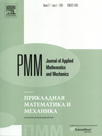 | | Journal of Applied
Mathematics and Mechanics
Russian Academy of Sciences | | Founded
in January 1936
(Translated from 1958)
Issued 6 times a year
ISSN 0021-8928
(print version) |
Archive of Issues
| Total articles in the database: | | 10482 |
| In Russian (Ï̀̀): | | 9683
|
| In English (J. Appl. Math. Mech.): | | 799 |
|
| << Previous article | Volume 79, Issue 1 / 2015 | Next article >> |
| A.M. Linkov, "The particle velocity, speed equation and universal asymptotics for the efficient modelling of hydraulic fractures," J. Appl. Math. Mech. 79 (1), 54-63 (2015) |
| Year |
2015 |
Volume |
79 |
Issue |
1 |
Pages |
54-63 |
| DOI |
10.1016/j.jappmathmech.2015.04.018 |
| Title |
The particle velocity, speed equation and universal asymptotics for the efficient modelling of hydraulic fractures |
| Author(s) |
A.M. Linkov (Saint Petersburg State Polytechnic University, Rzeszow University of Technology, linkoval@prz.edu.pl) |
| Abstract |
The theoretical rationale of the hydraulic fracture (HF) problem is revisited. It implies that the particle velocity is the primary physical quantity, the use of which has significant analytical and computational advantages over the conventional use of flux. The fundamental significance of the speed equation (SE) for the proper tracing of fracture propagation is emphasized. It appears that when the lag between the fracture contour and the fluid front is neglected, the asymptotic form of the continuity equation (CE) agrees identically with the SE for non-singular or weakly singular leak-off. For strongly singular leak-off of the Carter’ type, the asymptotic form of the CE yields a generalized speed equation. We show that for zero lag, the system, comprised of the asymptotic CE, the elasticity equation and fracture condition, defines the universal asymptotic solution (universal asymptotic umbrella) of the HF problem. Its remarkable property is that it depends solely on the local propagation speed. On one hand, this fact makes the HF problem ill-posed when neglecting the lag and trying to solve it as a boundary value problem for a fixed position of the front. On the other hand, when properly employed, it considerably facilitates analytical and numerical solutions. Specifically, one may use either highly efficient ɛ-regularization or inclusion of the SE as an additional equation with the front coordinate as an additional unknown what provides a well-posed dynamic problem. We show that the latter may be efficiently solved by a variety of methods including explicit and implicit level set methods. In view of the significance of the universal asymptotic umbrella, we derive a simple almost monomial universal solution applicable for any regime of HF propagation. |
| Received |
03 April 2014 |
| Link to Fulltext |
|
| << Previous article | Volume 79, Issue 1 / 2015 | Next article >> |
|
 If you find a misprint on a webpage, please help us correct it promptly - just highlight and press Ctrl+Enter If you find a misprint on a webpage, please help us correct it promptly - just highlight and press Ctrl+Enter
|
|

 Russian
Russian  English
English